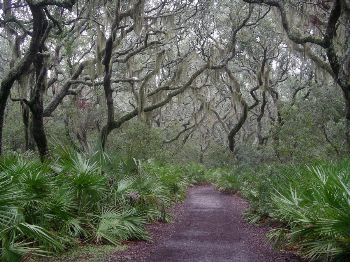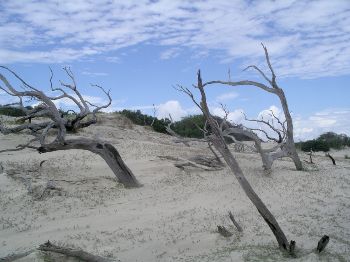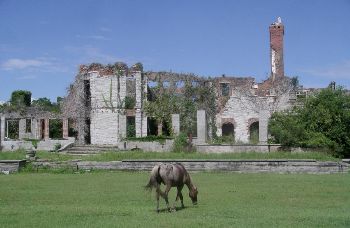October, 2007
Island Walk
by Valerie
I had my first opportunity to visit Cumberland Island National Seashore in Georgia this month. My mother, Evelyn, had been there over a year ago, but it was before her knee replacement surgery and, while she found the island intriguing, the pain tended to diminish the experience. The chance to return, sans physical problems, as well as allow me a chance to see the area, was too good to pass up.
 The only access to Cumberland is by private boat or public ferry. We caught the first of two ferry trips going out in the morning, and would need to make it back to the dock in time for the single ride back in the evening (we were camped at a nearby mainland state park). It was a dreary, drippy morning, so we wore our rain ponchos and also carried food and water because most of the 15 mile long island is undeveloped. The boat ride out had few passengers: besides us, there was a crew of two and a couple with three kids. When we arrived at the dock, it was crowded with soggy campers anxious to end their not-so-pleasant outing as early as possible (it had been raining for quite some time).
The only access to Cumberland is by private boat or public ferry. We caught the first of two ferry trips going out in the morning, and would need to make it back to the dock in time for the single ride back in the evening (we were camped at a nearby mainland state park). It was a dreary, drippy morning, so we wore our rain ponchos and also carried food and water because most of the 15 mile long island is undeveloped. The boat ride out had few passengers: besides us, there was a crew of two and a couple with three kids. When we arrived at the dock, it was crowded with soggy campers anxious to end their not-so-pleasant outing as early as possible (it had been raining for quite some time).
As soon as we disembarked, the rain began to abate and we headed out on a trail leading from the leeside to the open beach on the outer shore. The tall oaks covered with Spanish moss looked like an elegant wonderland, as their gray and black forms complemented the green palmettos of the understory.
At times, Cumberland receives hundreds of visitors, so trails are well marked and dunes have roads or boardwalks to prevent erosion to the surrounding fragile landscape. We planned a small loop tour of the island, which would take us through a variety of habitats, as well as pass a couple of sites that provided fresh drinking water, while not being overly ambitious about the distance we knew we would want to walk.
Arriving at the open and deserted beach at low tide, we found a huge area littered with all sorts of interesting detritus - a beachcomber's paradise. Recent storms had piled driftwood, dead fish, shells, and other things from the water's edge to the base of the dunes. The gradually clearing sky made for stunning cloudscapes as we explored about 1.5 miles of flat sandy shoreline. We found sea cucumbers, crabs, skate egg cases, barnacles, and even a small nudibranch (sea slug). Shorebirds scurried about as they fed, and piles of coquina clams in rainbow colors washed up and buried themselves with every wave.

We then headed inland again, following a road and boardwalk through the dunes, which would eventually take us to the marsh side of the island. An eerie landscape of dead trees buried by dunes was the highlight of this area. There were also stands of palms and various other kinds of vegetation that can withstand the wind, salt, and shifting sand.
A convenient boardwalk allowed us excellent views of the open salt marshes. There were even some thoughtfully placed plastic chairs so we could relax and watch the birds and the reflections of the clouds in the water. The boardwalk continued back to the more heavily vegetated side of the island, where we then took a trail through mixed open fields and thick woods. We saw the first of several herds of the wild horses that live on the island. Although they are completely untamed, they are used to people and so pretty much just ignored us. We also took a short side trail to an old cemetery. This was the only place where the mosquitoes became very annoying, so we didn't stay too long there.
The Carnegie family at one time had a big mansion on the island. There are still some buildings that are currently inhabited and maintained, but others have fallen into ruins. The mansion is the biggest and most impressive, crumbling away slowly in the middle of a huge lawn, complete with old retention walls, garden remains, decorative arches, and fountains. The horses wander about everywhere, and probably are responsible for cutting the grass. In this area we also saw a large flock of wild turkeys and an armadillo. It was easy to spend a long time walking all around the ruins, looking for the best photo angles and trying to avoid getting too close to the horses. As with much of our day, there were no other visitors around and it was like being on a deserted island all alone.
The last leg of our little trek took us down an oak-covered sand road that returned to the National Seashore visitor center and the dock where we would meet the ferry boat. We had a half hour to spare, and so plopped down on a picnic table to rest and watch the horses trimming the grass around the small dock where a couple people were fishing.
 Just as we settled down, a ranger came out of the visitor center and called us over, saying that a movie was starting and we were welcome to watch. Inside, which was delightfully air-conditioned, a small group of campers and a couple of rangers were watching a homemade video of a recent lightning display over Cumberland being played on a large widescreen television screen. Music had been added, and it was really quite engaging. After that short film, we watched one about the rescue of a large loggerhead turtle that had come to lay eggs but then got stuck in a tidepool instead of making it back to the ocean before the sun came up and confused her. A turtle researcher managed to guide the 300 pound reptile back to the waves while a ranger took videos of the whole process. One final film was a montage of some of the wildlife on the island, set to music from Stravinsky's "The Firebird." This entertainment took us all the way up to the time when the boat would depart.
Just as we settled down, a ranger came out of the visitor center and called us over, saying that a movie was starting and we were welcome to watch. Inside, which was delightfully air-conditioned, a small group of campers and a couple of rangers were watching a homemade video of a recent lightning display over Cumberland being played on a large widescreen television screen. Music had been added, and it was really quite engaging. After that short film, we watched one about the rescue of a large loggerhead turtle that had come to lay eggs but then got stuck in a tidepool instead of making it back to the ocean before the sun came up and confused her. A turtle researcher managed to guide the 300 pound reptile back to the waves while a ranger took videos of the whole process. One final film was a montage of some of the wildlife on the island, set to music from Stravinsky's "The Firebird." This entertainment took us all the way up to the time when the boat would depart.
Our return trip was even less crowded than the initial ride: there were only four passengers including us. We spent most of the 45-minute boat ride on the upper level, enjoying the views of the islands, salt marshes and evening sky. We'd probably walked only about 6-7 miles that day, but had spent seven hours completely captivated by this remote national seashore.
 The only access to Cumberland is by private boat or public ferry. We caught the first of two ferry trips going out in the morning, and would need to make it back to the dock in time for the single ride back in the evening (we were camped at a nearby mainland state park). It was a dreary, drippy morning, so we wore our rain ponchos and also carried food and water because most of the 15 mile long island is undeveloped. The boat ride out had few passengers: besides us, there was a crew of two and a couple with three kids. When we arrived at the dock, it was crowded with soggy campers anxious to end their not-so-pleasant outing as early as possible (it had been raining for quite some time).
The only access to Cumberland is by private boat or public ferry. We caught the first of two ferry trips going out in the morning, and would need to make it back to the dock in time for the single ride back in the evening (we were camped at a nearby mainland state park). It was a dreary, drippy morning, so we wore our rain ponchos and also carried food and water because most of the 15 mile long island is undeveloped. The boat ride out had few passengers: besides us, there was a crew of two and a couple with three kids. When we arrived at the dock, it was crowded with soggy campers anxious to end their not-so-pleasant outing as early as possible (it had been raining for quite some time).

 Just as we settled down, a ranger came out of the visitor center and called us over, saying that a movie was starting and we were welcome to watch. Inside, which was delightfully air-conditioned, a small group of campers and a couple of rangers were watching a homemade video of a recent lightning display over Cumberland being played on a large widescreen television screen. Music had been added, and it was really quite engaging. After that short film, we watched one about the rescue of a large loggerhead turtle that had come to lay eggs but then got stuck in a tidepool instead of making it back to the ocean before the sun came up and confused her. A turtle researcher managed to guide the 300 pound reptile back to the waves while a ranger took videos of the whole process. One final film was a montage of some of the wildlife on the island, set to music from Stravinsky's "The Firebird." This entertainment took us all the way up to the time when the boat would depart.
Just as we settled down, a ranger came out of the visitor center and called us over, saying that a movie was starting and we were welcome to watch. Inside, which was delightfully air-conditioned, a small group of campers and a couple of rangers were watching a homemade video of a recent lightning display over Cumberland being played on a large widescreen television screen. Music had been added, and it was really quite engaging. After that short film, we watched one about the rescue of a large loggerhead turtle that had come to lay eggs but then got stuck in a tidepool instead of making it back to the ocean before the sun came up and confused her. A turtle researcher managed to guide the 300 pound reptile back to the waves while a ranger took videos of the whole process. One final film was a montage of some of the wildlife on the island, set to music from Stravinsky's "The Firebird." This entertainment took us all the way up to the time when the boat would depart.